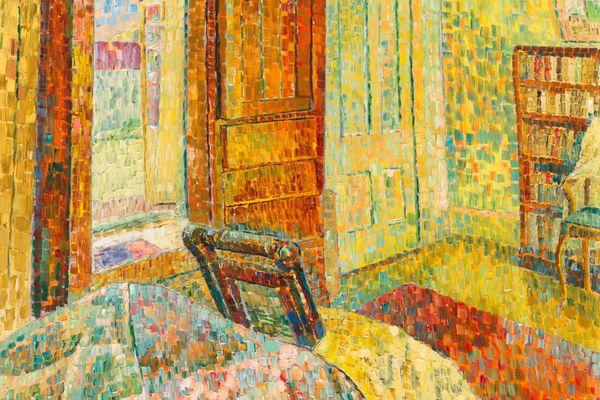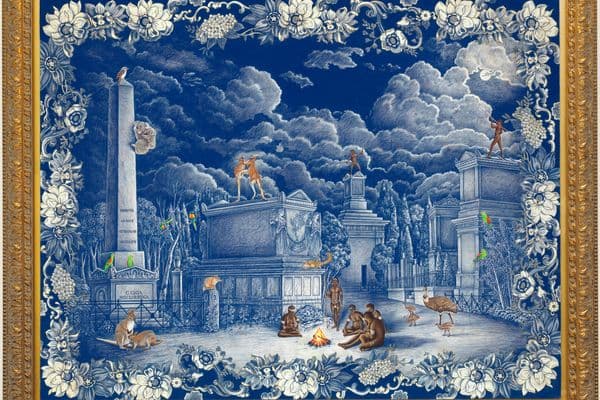R.B. Kitaj
///national-gallery-of-australia/media/dd/images/R_B_Kitaj_22500.jpg)
RB Kitaj. Image courtesy of Library Special Collections, University of California, Los Angeles
R.B. Kitaj is one of the most unorthodox yet influential figures in contemporary art. He was born Ronald Brooks on 29 October 1932, in Cleveland, Ohio. Deserted by his father when a baby, he grew up with his mother, Jeanne, a secular Jew, who married Dr Walter Kitaj—a Jewish refugee from Vienna. The family was agnostic and it was only when Kitaj was a student in Vienna that he realised that despite the fact that he considered himself to be an ‘all–American boy’, his counterparts in Vienna would not have been so lucky. ‘Imagine what it felt like … to walk down a street and know that people there had been pulled out by the Gestapo and sent off to concentration camps. It was really my first serious awareness of being a Jew.’ 1
Following studies at the Akademie der Bildenden Künste in Vienna and the Ruskin College of Art, Oxford, Kitaj succeeded in his application to study at the Royal College of Art, London, in 1959. As he had spent several years as a GI and seaman, he was older and more experienced than fellow students such as David Hockney and Allen Jones. Kitaj was considered a leading figure in this group of emerging artists. A character of many dimensions, Kitaj was described as the only man ‘in the western world who knows who Lavell ‘Sugar Bear’ Blanks, Joe Kling and Walter Benjamin are.’2 Throughout his career, his interests, sources, influences and explorations have meant Kitaj often has produced rich and complex art.
In 1960 Kitaj ‘stole the show’ in the Young Contemporaries exhibition in London and was invited as a new artist to join the stable of artists at Marlborough Fine Art. In 1963 he had his first solo exhibition at Marlborough‘s New London Gallery, R. B. Kitaj: Pictures with Commentary, Pictures without Commentary. It was during the 1960s that Kitaj developed his style of collaging imagery of motifs, inspired by the Surrealists and poets such as Ezra Pound, producing an art of strange evocative juxtapositions in a loosely–brushed, painterly manner.
In 1969, following the death of his first wife, Kitaj went to live in the United States, renting a house in Hollywood and teaching at UCLA. It was during this time that the artist visited Ken Tyler’s workshop, Gemini GEL, Los Angeles with artist David Hockney and curator and writer, Maurice Tuchman. According to Tyler, ‘We discussed the creation of a photographic collage print: Ron drew on the plate; the halftone separations were made by an outside commercial printer; the film was made up on to a direct photographic negative–type aluminium plate at the workshop, and Ron Olds printed the edition after I proofed the RTP.’3 The print was entitled Aviator, 1971, and combined an image from Wings, with lithographic drawing of a wild–eyed, toothy pilot.
In the mid 1970s Kitaj rejected his previous style of arranged compositions inspired by Surrealist notions, turning to the art of drawing and the primacy of the human figure. Signifying the change in direction was an exhibition Kitaj curated for the Arts Council of Great Britain, which he called The human clay, citing W H Auden’s line from his Letter to Lord Byron, ‘To me Art’s subject is the human clay’. It was at this time Kitaj adopted a term for the group of figurative artists emanating from London, ‘The School of London’ (originally coined by David Sylvester in 1948 in an article for the French press on the problems concerning French and English art in 1947)4 whom he believed were artists of consequence, but not swept up by the current fashions of Minimalism and Conceptualism.
Jane Kinsman
Senior Curator of International Prints, Drawings and Illustrated Books
Further Reading
NATIONAL GALLERY PUBLICATIONS
- Workshop: The Kenneth Tyler Collection, Jane Kinsman (ed.), 2015
RELATED LINKS











